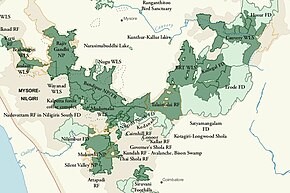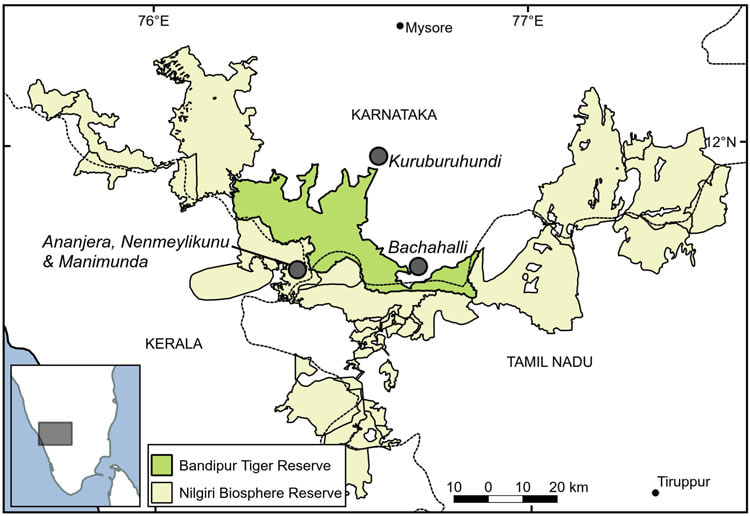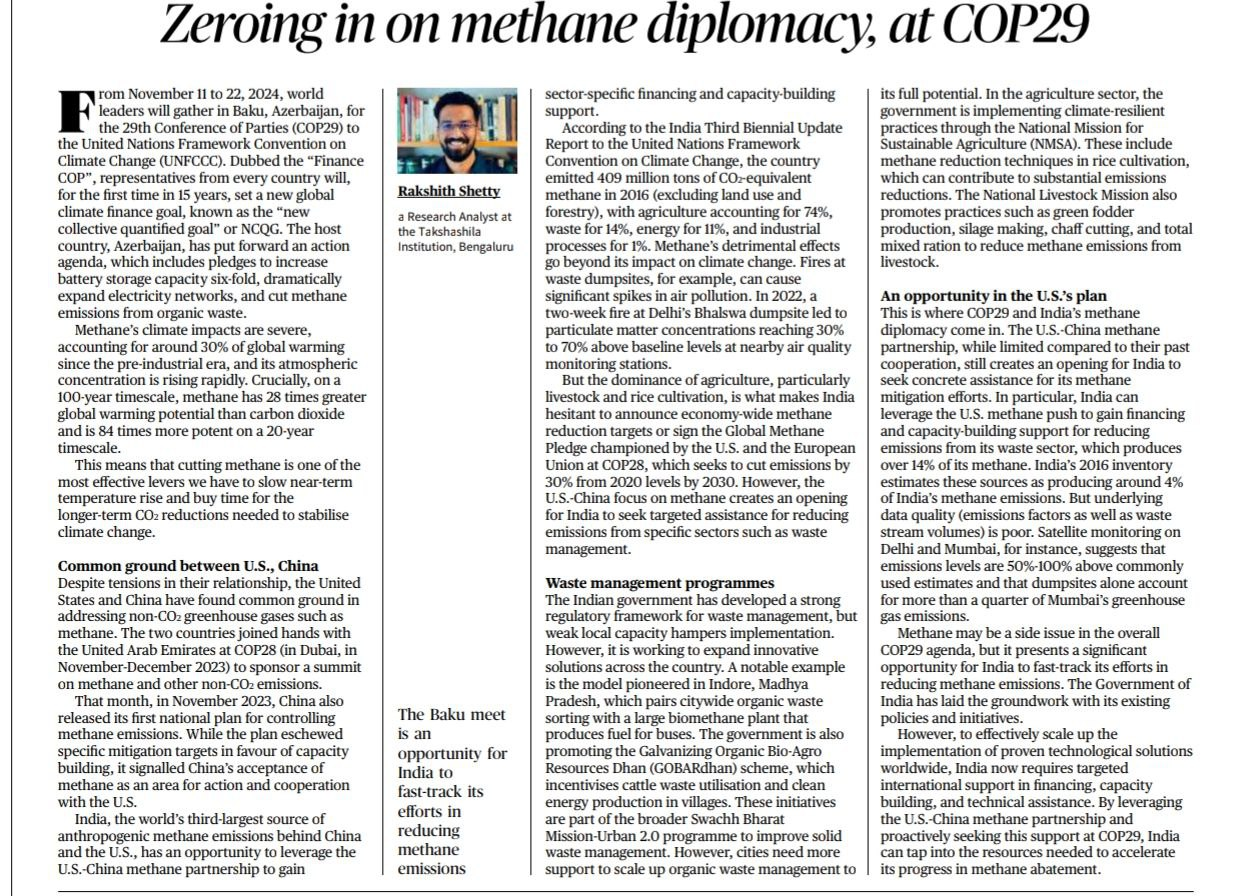1. Nilgiri Biosphere Reserve and its Conservation
Introduction
- The Nilgiri Biosphere Reserve, declared by UNESCO in 2000, is a rich ecological hub spread over 5,500 square kilometers across Karnataka, Kerala, and Tamil Nadu. It is one of India’s oldest biosphere reserves, home to rich biodiversity, including species like the Nilgiri tahr and the shola grasslands.
- The article emphasizes the evolving challenges in the conservation of Nilgiris, amidst increasing human activity such as tourism, plantations, and forest encroachments. It also discusses the importance of involving local communities and integrating modern technology to maintain balance.
Challenges in Conservation
- Human Activity:
- Tourism, agriculture, and expanding plantations pose a threat to the ecological balance.
- Day-trippers and waste management issues have exacerbated environmental degradation.
- Encroachment and Conflict:
- Farmers and locals, increasingly dependent on pesticide-heavy farming, contribute to pollution and habitat destruction.
- Growing human-wildlife conflict, especially involving animals like elephants and leopards, highlights a need for harmony between humans and nature.
- Governmental Role and Policy:
- The Forest Department and State administration aim to protect the Nilgiris, but often their efforts are not enough without public involvement.
- Policies such as the Wildlife (Protection) Amendment Act of 2022 allow wild animals to belong to the state, reinforcing the need for collective accountability.
- Indigenous Communities:
- Involvement of the Irula and Toda tribes is crucial for conserving the Nilgiris. These tribes have deep-rooted knowledge of the ecosystem.
- The Keystone Foundation works with indigenous communities to create sustainable practices.
Conservation as a Shared Responsibility
- Local Involvement:
- Conservation efforts must include local communities, who depend on these areas for livelihood and cultural identity.
- Citizen science initiatives and public-private partnerships are vital for promoting sustainable agricultural and land-use practices.
- Technology and Governance:
- Drones, AI-based tracking, and community surveillance can help monitor wildlife and manage conflicts.
- Conservation strategies should also integrate sustainable farming techniques, minimizing pesticide use and protecting water sources.
- Storytelling and Awareness:
- Storytelling is a key tool for spreading awareness about the importance of biodiversity and wildlife conservation.
- The article highlights a new documentary, The Nilgiris – A Shared Wilderness, which emphasizes the need for holistic conservation approaches by sharing stories of the region’s beauty and fragility.
Conclusion
- The Nilgiri Biosphere represents not only a rich natural heritage but also the need for collective stewardship of ecosystems.
- Collaborative conservation, integrating technology, and involving local and indigenous communities are essential to ensure the resilience of the Nilgiris.
- Storytelling and awareness are crucial to fostering a global sense of responsibility and care for such unique wilderness areas.
Mains Practice Question
|
Q. “The Nilgiris Biosphere Reserve is a testament to India’s rich ecological heritage, but its conservation requires collective responsibility.” Discuss the challenges in maintaining the balance between development and conservation in the Nilgiris, and suggest ways to overcome them.
|
2. Methane Diplomacy at COP29: India's Strategic Opportunities and Challenges
Introduction
- COP29, set to take place in November 2024 in Baku, Azerbaijan, will focus on key global climate finance goals, marking the first such effort in 15 years.
- Methane is a potent greenhouse gas (GHG), 28 times stronger than carbon dioxide over a 100-year period. It accounts for about 30% of global warming and is particularly significant for short-term climate mitigation.
- The event is critical for global methane diplomacy, especially in light of cooperation between major emitters like the U.S. and China.
Why Methane Reduction is Crucial
- Methane’s Climate Impact:
- Methane’s contribution to global warming has been rapidly increasing, with major sources including agriculture, organic waste, and industrial processes.
- Methane’s atmospheric concentration is rising faster than that of CO₂, and cutting methane emissions could provide immediate climate benefits, buying time for long-term CO₂ reductions.
- India’s Methane Profile:
- According to India’s Third Biennial Update Report, India emitted 409 million tons of CO₂-equivalent methane in 2016, with agriculture contributing 74%.
- India’s methane emissions are largely driven by rice cultivation, livestock, and waste management. Fires at landfills, such as the one at Delhi’s Bhalswa dumpsite, show methane’s direct impact on air quality.
- Methane emissions from waste alone make up over 14% of India’s total methane output.
Methane Diplomacy at COP29
- S.-China Cooperation:
- Despite geopolitical tensions, the U.S. and China found common ground in methane control, co-sponsoring a global summit in 2023 and launching the Global Methane Pledge to reduce emissions.
- India can leverage this dynamic to advance its methane diplomacy, especially in sectors like waste management and agriculture.
- Opportunities for India:
- India has already made strides with policies such as the National Livestock Mission and the National Mission for Sustainable Agriculture (NMSA), which promote methane-reducing practices in agriculture.
- However, India can further benefit by collaborating with the U.S. and European Union through capacity-building, financing, and technology transfers under initiatives like the Global Methane Pledge.
- Waste Management as a Key Focus:
- India has developed a strong framework for waste management, but capacity-building is weak.
- Model projects, like the Indore-based GobarDhan scheme, which uses cattle waste for bio-energy, showcase innovative approaches. However, broader implementation and scaling up remain challenging.
India’s Strategic Interests at COP29
- Technological Assistance: India can seek targeted international support for satellite monitoring, innovative technologies for organic waste processing, and methane emission estimates in major urban areas like Delhi and Mumbai.
- Policy Expansion: Beyond existing measures, India needs stronger international partnerships to ensure long-term methane management, particularly in high-emitting sectors like agriculture and solid waste.
- Global Financing and Capacity Building: The creation of a new collective quantified goal (NCQG) at COP29 for global climate finance offers India an opportunity to secure funding for methane reduction projects, which are essential for both environmental and public health improvements.
Conclusion
- Methane diplomacy is poised to play a significant role at COP29, and India’s engagement will be crucial in driving its own methane mitigation agenda.
- By aligning with global methane reduction efforts, India can advance its existing policies and harness international support to tackle the growing challenge of methane emissions.
- Cooperation with global powers like the U.S. and China could accelerate India’s transition to cleaner practices, especially in agriculture and waste management sectors.
Mains Practice Question
|
Q. “Methane is one of the most effective levers to slow down short-term temperature rise.” Discuss the significance of reducing methane emissions in the context of India’s climate action and its potential role in COP29 negotiations.
|





